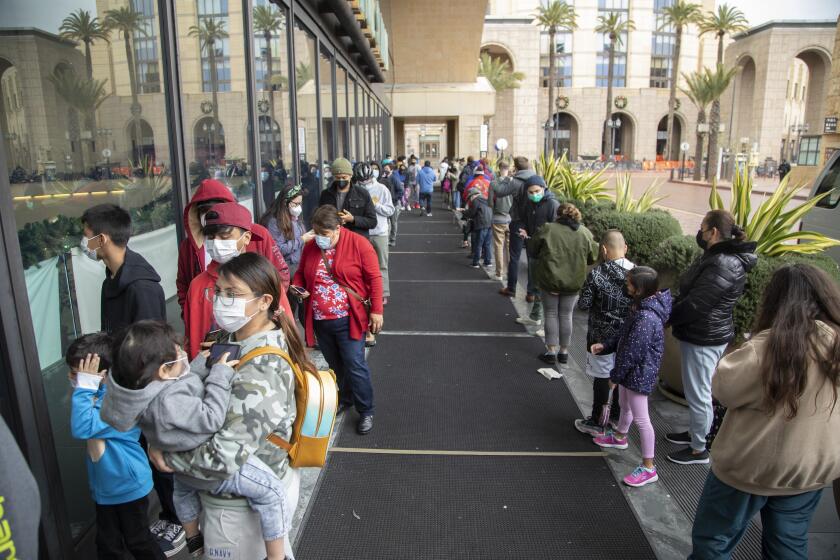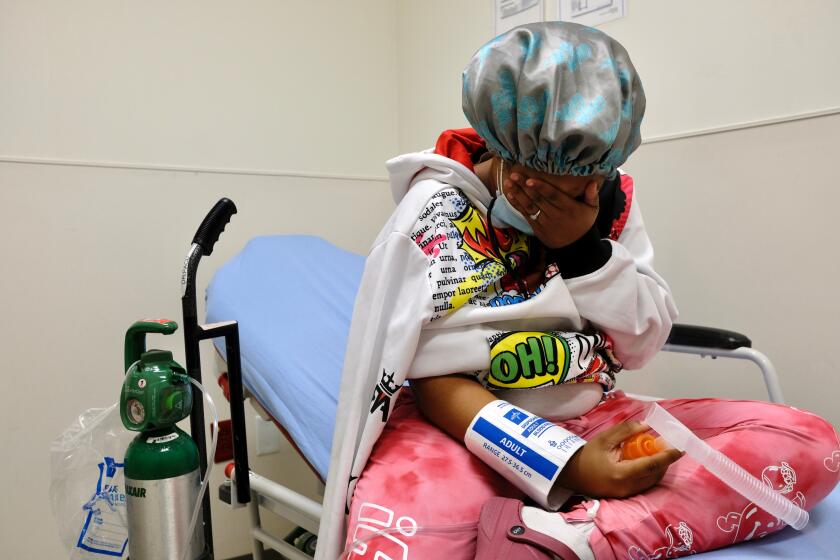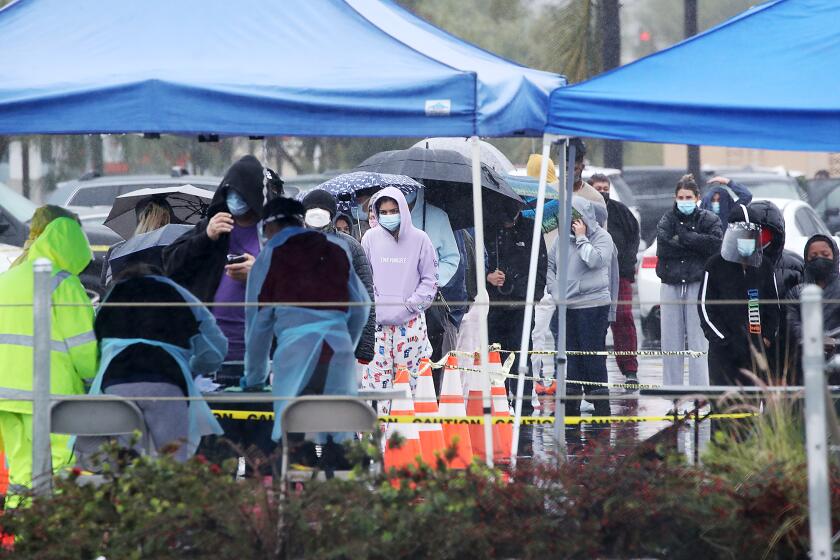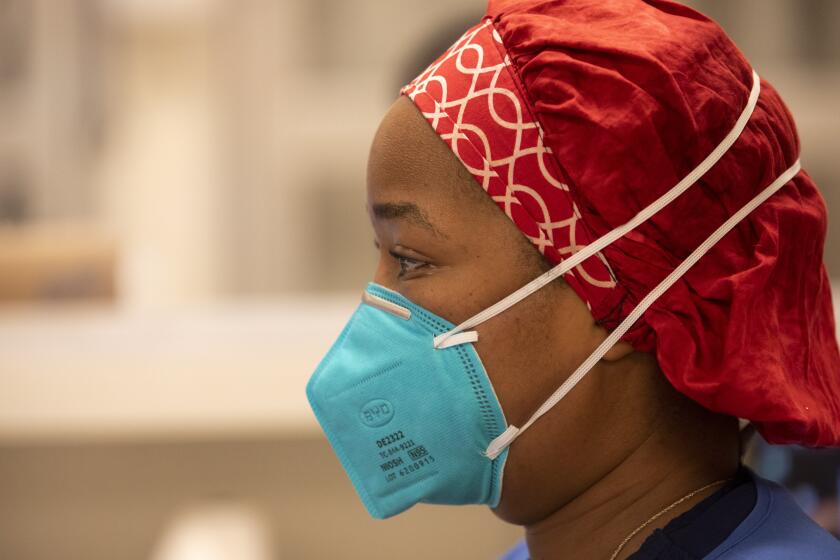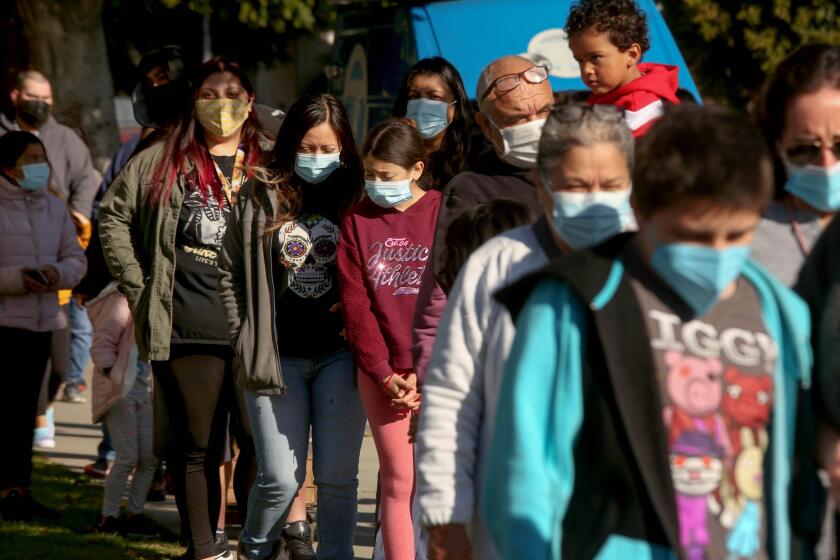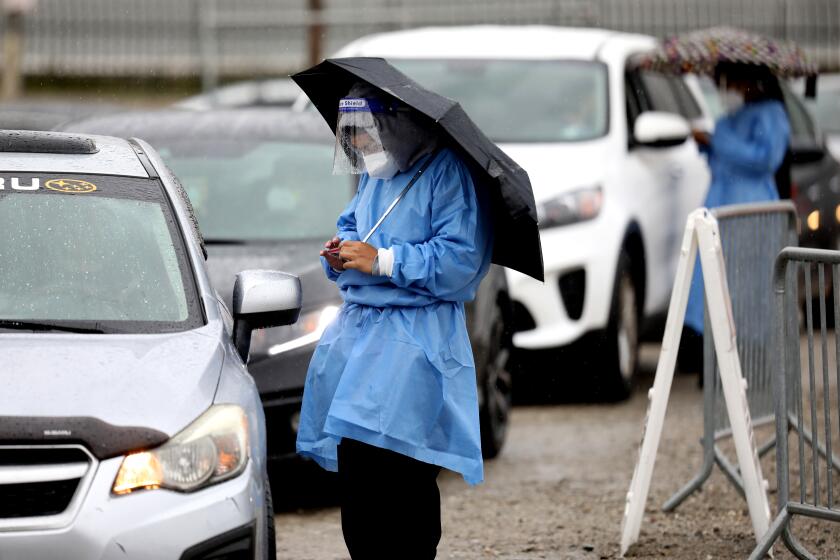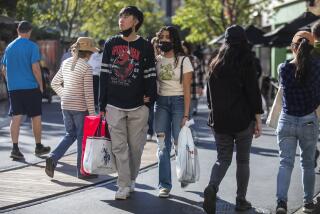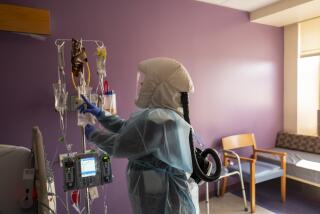L.A. County coronavirus transmission rate at highest point since early months of pandemic
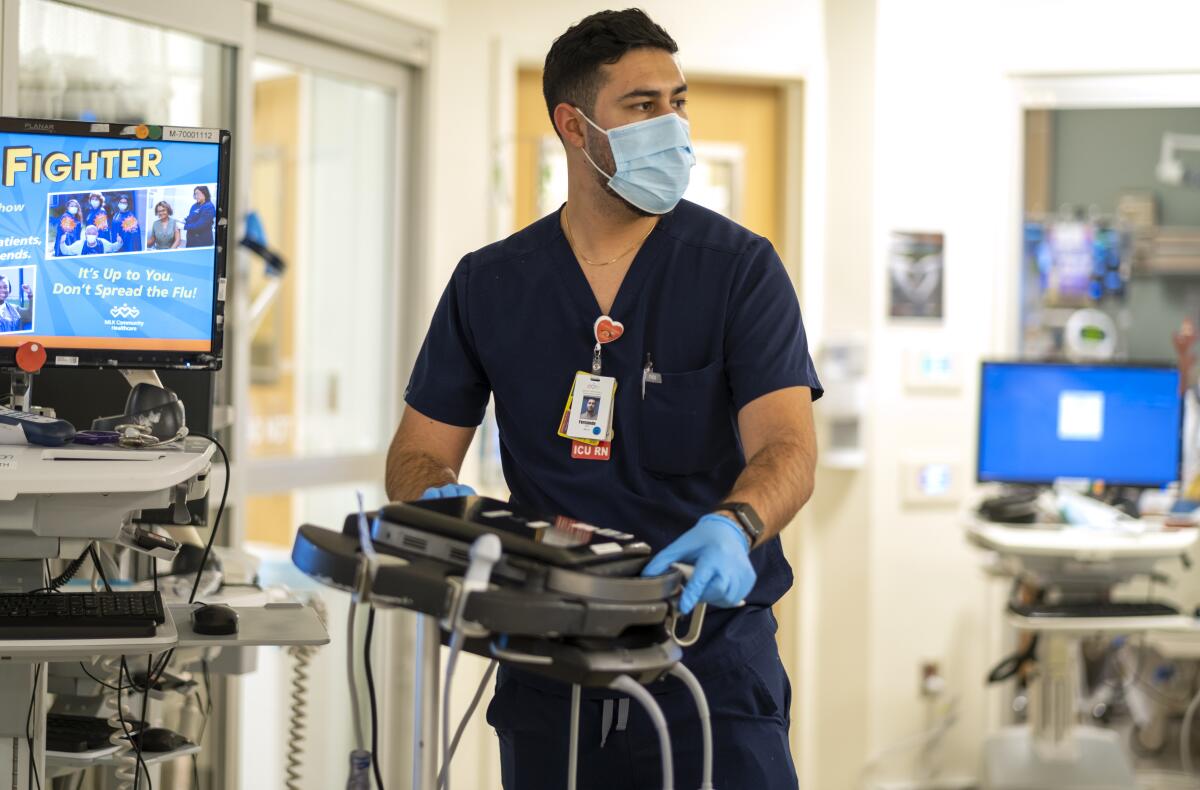
In a dramatic sign of Omicron’s relentless spread, the coronavirus transmission rate in Los Angeles County is now estimated to be greater than at any point since the early months of the pandemic, as cases explode across California, data show.
Every infected person in L.A. County is on average transmitting the virus to two other people, according to estimates from California’s COVID-19 computer models published Monday morning.
By contrast, the effective transmission rate at its worst point in last winter’s surge did not exceed 1.4, estimates from the L.A. County Department of Health Services show.
Over the last week, more than 1 in 5 of those tested in L.A. County found they have contracted the coronavirus.
L.A. County recorded 23,553 new cases on Saturday and 21,200 more on Sunday, far above last winter’s peak average of 16,000 cases a day; and those numbers are likely undercounts due to lags from weekend reporting. Officials say the latest wave is fueled by a few factors, including increased travel, large holiday gatherings and the ultra-contagious Omicron variant, estimated to be two to four times as transmissible as the Delta variant.
The winter spread of coronavirus cases is worsening. Here’s the latest advice on protecting yourself and those around you.
County health officials urged residents to curtail higher-risk activities, such as indoor events where people are unmasked for long periods of time and crowded outdoor gatherings.
Elsewhere in Southern California, the coronavirus transmission rate as of Monday morning is estimated at 2.1 in Orange County; 1.8 in Riverside, San Bernardino, Ventura and San Luis Obispo counties; and 1.7 in San Diego and Santa Barbara counties.
In Northern California, the coronavirus transmission rate was 2.3 in Contra Costa County; 2 in Santa Clara and San Mateo counties; 1.9 in San Francisco and Marin County; and 1.8 in Alameda, Sonoma and Napa counties.
The statewide transmission rate is 1.8.
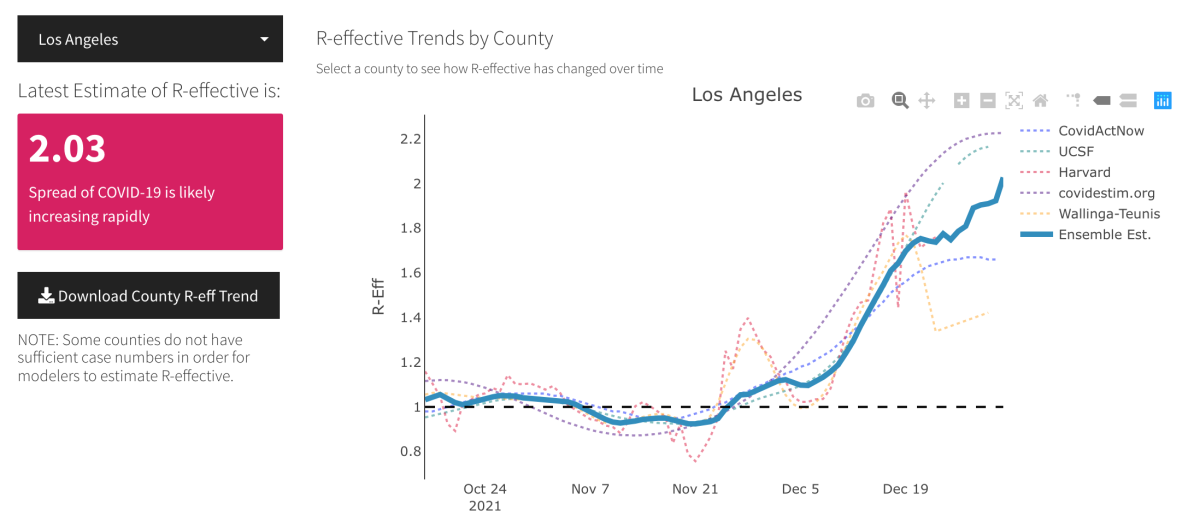
The estimated prevalence of coronavirus cases is so high that it would be pretty likely a person would encounter an asymptomatic infected person at an event with only 25 people, according to calculations by California’s public health director and state health officer, Dr. Tomás Aragón.
Aragón based his calculations on a recent statistic from UC San Francisco hospitals showing that 7.8% of fully vaccinated people tested positive for the coronavirus while being asymptomatic. (It’s even more likely that unvaccinated people will test positive, even when asymptomatic.)
Based on that data, there is an 87% chance that at least one person among 25 asymptomatic vaccinated people eating and drinking together is spewing out coronavirus particles into the air, Aragón wrote.
New daily cases are doubling every two days in L.A. County, with over 70% in adults under 50. Hospitalizations remain lower than in previous surges.
Dr. Robert Wachter, chair of UC San Francisco’s Department of Medicine, said he is “now seeing undeniable” surge in COVID-19 hospitalizations; as of New Year’s Eve at UC San Francisco hospitals, there were 45 coronavirus-positive patients versus 20 the week before.
“So tsunami of cases IS translating into some serious ones,” Wachter wrote. “Be super careful—it’s raining COVID.”
By Sunday night, Wachter wrote that while it’s too soon to be sure — especially with potential transmission over the New Year’s holiday — there might be a plateau in COVID-19 hospitalizations at UC San Francisco’s hospitals.
“Next few days will be key,” Wachter wrote. “Until we see sharp downturn, I’m in uber-careful mode.”
Meanwhile, evidence is mounting that booster shots strongly reduce the chance for hospitalization. A report from Britain showed that a booster shot resulted in an 88% vaccine effectiveness against hospitalization due to infection from the Omicron variant, Dr. Eric Topol, director of the Scripps Research Translational Institute in La Jolla, wrote Friday.
The rapid increase in COVID cases reflects ‘the exceptionally transmissible’ quality of the Omicron variant, CDC director Dr. Rochelle Walensky says.
Data are also accumulating suggesting Omicron generally results in a reduced chance for hospitalization compared with the Delta variant. Studies have shown that Omicron results in a decreased likelihood of infection of the lungs; Omicron owes its ultra-contagiousness to being very good at infecting the upper respiratory system.
While this makes it less likely adults will suffer problems breathing, Omicron could pose a problem with very young children, “toddlers who have trouble with upper airway infections. And you’re in fact seeing more croup-like infections and bronchiolitis in New York City among children,” Dr. Scott Gottlieb, a former commissioner of the U.S. Food and Drug Administration, told CBS’ “Face the Nation” on Sunday. “So, that could be a challenge for young kids, and we are seeing rising hospitalizations among that pediatric segment.”
Children under the age of 5 are not eligible for the COVID-19 vaccine.
Nationwide, the U.S. is averaging about 400,000 new coronavirus cases a day, Dr. Anthony Fauci, the U.S. government’s top infectious-diseases expert, told ABC’s “This Week” on Sunday. This exceeds the pandemic’s previous peak of about 250,000 cases a day last winter.
“The acceleration of cases that we have seen is really unprecedented, gone well beyond anything we have seen before,” Fauci said.
New school rules in L.A. County also lay out when testing is needed for close contacts to remain in class.
So far, however, COVID-19 hospitalizations have not risen as fast as coronavirus cases would suggest they would, which could be a result of Omicron’s lower severity on average to many people. Still, Fauci said officials are worried that because so many more people are getting infected in this wave, it’s possible hospitals will be stressed with many people needing hospitalization.
COVID-19 hospitalizations are increasing in Southern California and the San Francisco Bay Area, but remain at a fraction of where they were a year ago, when very few people had been vaccinated. Los Angeles County recorded 1,792 people hospitalized with a coronavirus infection on New Year’s Day, double the number since Christmas, when there were 904.
Saturday’s tally was still only one-quarter of the total from last year, when there were 7,544 COVID-19 patients in hospitals on Jan. 1, 2021.
Orange County’s COVID-19 hospitalizations also doubled since Christmas. On New Year’s Day, the county posted 522 coronavirus-infected people in its hospitals, double the number on Christmas Day, when there were 256. A year ago, Orange County had 2,057 COVID-19 patients in its hospitals.
Across California, COVID-19 hospitalizations have risen by 65% over the same time period. On Christmas Day, 3,781 people were in California’s hospitals with coronavirus infections; by New Year’s Day, there were 6,237. A year earlier, there were 20,344 people with coronavirus infections in California’s hospitals.
Health officials say it’s important to improve the fit of face masks and their filtration, going beyond old, loose, cloth face coverings.
Southern California has the worst COVID-19 hospitalization rate on a per capita basis in California; for every 100,000 residents, 19 are in hospitals with a coronavirus infection; the rate is 16 for the greater Sacramento area, 15 in the San Joaquin Valley, 9 in the San Francisco Bay Area and 5 in rural Northern California. Experts say it’s a sign of concern when the rate is 5 or greater.
Within Southern California, the Inland Empire has the worst rate, with San Bernardino County reporting a rate of 29, and Riverside County, 23. San Diego County’s rate is 19; L.A. County, 18; Orange County, 16; and Ventura County, 15.
Faced with criticism, the U.S. Centers for Disease Control and Prevention is considering tightening newly relaxed recommendations on when asymptomatic infected people can exit isolation, according to Fauci. Last week, the CDC said asymptomatic people can leave isolation following the fifth day after testing positive — without being required to get a negative rapid test.
Some health experts criticized the CDC’s guidelines as too lax, and the California Department of Public Health on Thursday issued its own guidelines that recommend getting a negative test to exit isolation after the fifth day. (People can also wait until after the 10th day to exit isolation without a negative test.)
The state has issued new recommendations for when people infected with COVID-19 can end their isolation, guidance that is stricter than the CDC’s.
“There has been some concern about why we don’t ask people at that five-day period to get tested. That is something that is now under consideration,” Fauci told ABC of the CDC’s deliberations. “The CDC is very well aware that there has been some pushback about that ... and I think we’re going to be hearing more about that in the next day or so from the CDC.”
Times staff writer James Rainey contributed to this report.
More to Read
Start your day right
Sign up for Essential California for news, features and recommendations from the L.A. Times and beyond in your inbox six days a week.
You may occasionally receive promotional content from the Los Angeles Times.
